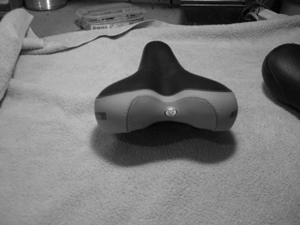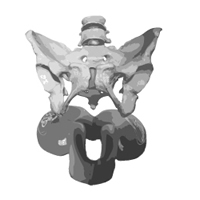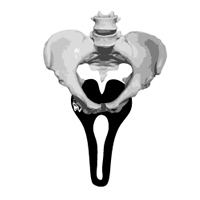Besides the obvious, what, ergonomically, makes a day on the saddle so different from a day in the office?
When sitting in a chair, weight is dispersed over a broader surface area including the upper thighs. The legs assist in elevating the soft tissue of the genitals ever-so-slightly off a wider surface that also allows for weight shifting and repositioning.
By comparison, when you ride a bicycle, your weight is transmitted to a much smaller surface area through your ischial tuberosities (sit bones). Your legs are active as they spin and propel you forward, rather than just buffering your points of contact with the saddle. The specific areas of contact put pressure on the pudendal nerve, and since nerves, arteries and veins generally travel together, blood flow is also compromised. Leaning forward on the handlebars puts additional pressure on the perineal or soft tissue region of the female anatomy and can cause urinary and sexual dysfunction.
The constant pressure on the relatively small surface area of a saddle requires that the sit bones are correctly positioned, and that the shape of the saddle conforms to the other boney structures it comes in contact with– like the pubic rami. Since a woman’s pelvis is generally wider and shorter, it would seem logical that her saddle would reflect those differences. But every woman is different, and a men’s saddle may offer more comfort in some instances. Remember, the pelvis is not static, and the ischial tuberosities spread apart in a more upright position versus the more aggressive position of a racer.
Obviously, the lack soft tissue (muscle, fat, etc) on these diagrams, limits their accuracy. But, you get the idea.
I’ve never actually worn out a saddle. But I’ve had one wear on me, leaving tissue so raw I thought I’d permanently damaged my clitoris. In retrospect, this particular incident was not caused by the saddle itself, but by riding a bicycle at least three sizes too big. Overall, my saddle dramas do not compare to those of my friend, Sue.
Sue is an intelligent woman, a chiropractor, acupuncturist and dedicated cyclist who rode 11 or so miles every few days on her Kona “Dew” as part of her cross training fitness. She bumped her training up for Cycle Oregon and found the limiting aspect to her bicycle enjoyment was her saddle. Here’s what happened when she decided to take matters into her own hands.

She continued training until it was apparent her high mileage required a different kind of bike and she spent considerable hours trying road bikes over a three day period before purchasing a men’s 50 cm Trek 2.3 with a Bontrager saddle.
I can’t emphasize proper bike fit enough. If your saddle is too high, the rocking motion of your pelvis on the saddle will no doubt cause chafing and pain. The same is true if the saddle is too far back or too far forward and you are constantly pushing yourself in one direction or the other for comfort. If your reach is too extended then you may be leaning on your saddle in a manner other than the way it was designed.
There is no magic formula for finding the perfect saddle to fit your anatomy and riding style. All of us will eventually resort to some process of trial and error when we have to replace a worn saddle that is no longer available. To minimize your expense first you’ll need to get some measurements.
1. Use your local bike shop- most stores are either Trek or Specialized dealers and both companies have their own device used to measure the distance between ischial tuberosities. Make use of these resources. Bontrager doesn’t offer a numeric measurement with their device, so it’s wise to bring along your own tape measure and record the results. Remember to mimic the position you most commonly ride in, or take two measurements — one in an aggressive position and one more upright since the relative distance between the ischial tuberostities will widen while you are upright. Measure from the middle of each point of contact. Write down the numbers and when you get home you can get the average. By adding 10-20 mm from those points of contact, you will have a measurement range for the correct width of your saddle. Remember, you don’t have to buy a saddle from the bike store. Remember also, that no one, not even an experienced bike fitter, can determine what size saddle will fit you without one of these devices.
2. Cheek to Cheek- For a mere $16.95, WeKeepYouCycling.com offers a one-time throw away device called the “Cheek to Cheek” to determine the proper seat width in the privacy of your own home.
Once you have this measurement, find a dealer with a generous return policy. Terry, for example, has a “ride it and love it or return it,” guarantee, which allows you 30 days to evaluate whether the saddle is comfortable. Take advantage of this offer and ride your bike both short and long distances. Sometimes it takes sixty miles before a saddle becomes unbearable.
Your other option is to call an expert. I have been extremely impressed with Rob Poulton at We Keep You Cycling. He is dedicated to helping you find the best fitting saddle and boasts over a 90% success rate on the first try. He accomplishes this with a series of interview questions in addition to the Cheek-to-Cheek measurements. Be forewarned, he will not accept a returned saddle that has been mounted on your bike. To determine if one of his saddles is the correct fit, place the saddle on a coffee table or hard chair and sit on it, mimicking your position as if you were riding your bike. Rob can help you narrow down your choices and help determine your seat width, even if you’ve used a measuring device from your local bike shop.
| Make | Model | Length
mm |
Width mm | Weight gm | Cover Material | *Test Ride **Guarantee |
|---|---|---|---|---|---|---|
| Terry | Butterfly Tri-Gel | 262 | 155 | 294 | leather | * * |
| Bontrager | Inform RL WSD 3 sizes | 260 | 140 150 160 | 235 245 255 | “synthetic leather” | * * |
| Selle SMP | Avant | 269 | 154 | 335 | nap leather | * |
| WTB | Deva SLT | 257 | 142 | 225 | perforated leather | * |
| Specialized | BG Lithia Gel Saddle | 270 | 130 143 155 | 245 260 295 | micromatrix | * |
| Selle Italia | Diva Gel Flow | 265 | 160 | 265 | leather | * |
*Click on the links to get more style and size information
directly from each manufacturer.



